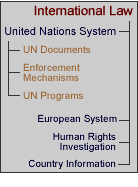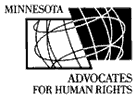UN Commission on Human Rights and the Sub-Commission
on the Promotion and Protection of Human Rights
The Sub-Commission on the Promotion
and Protection of Human Rights has the authority to review “situations which
reveal a consistent pattern of violations of human rights” and present recommendations
to the Economic and Social Council (ECOSOC). Since 1970, the Sub-Commission
on the Promotion and Protection of Human Rights can consider individual communications,
under a procedure known and the 1503 Procedure. The 1503 Procedure is limited
in scope. It enables two UN bodies, the Sub-Commission on the Promotion and
Protection on Human Rights and the Commission on Human Rights to investigate
specific types of complaints- those which appear to show consistent or widespread
patterns of gross and reliably attested human rights abuses. The 1503 Procedure,
however, applies broadly to any country in the world, not only UN members.
The 1503 Procedure, as amended
in 2000, allows the complaints to remain confidential, unless the national
government indicates that they should be made public. At the same time, the
1503 procedure allows the authors of a complaint to have their names deleted
and identities not revealed to the government.
Note that the
Commission on Human Rights is not the same body as the Human
Rights Committee. The Human Rights Committee is a treaty-monitoring
body that enforces the International Covenant on Civil and Political Rights.
The mandate of the Commission on Human Rights is to examine, monitor and report
on human rights situations worldwide. Most of the work of the Commission
on Human Rights concerns reporting and monitoring mechanisms, rather than
direct complaint mechanisms. The 1503 Procedure, although it is a complaint
mechanism, functions more like reporting in that its purpose is to provide
information on patterns of human rights violations and not to redress individual
wrongs.
The Economic and Security Council
also created by resolution the 1235 Procedure, which should not be confused
with the 1503 Procedure. The 1235 Procedure allows the Commission on Human
Rights to create an ad hoc working group of its own members for public
study of gross violations of human rights. Based on its own study the Commission
makes recommendations to the Economic and Security Council. Individuals cannot
use the 1235 Procedure, although NGOs can access this mechanism.
The 1503 Procedure is similar
to the procedure under the Commission on the Status of
Women (CSW) complaint procedure under the Commission on the Status of
Women.
The major distinction, however, is that the purpose of the complaint procedure
under the CSW is to identify global trends and patterns
of abuse of women’s rights, while the 1503 Procedure focuses on widespread
human rights abuses in specific countries.
The 1503 complaint
procedure is summarized below.
The ”1503
Procedure”
Type of Mechanism |
Complaint- information procedure |
Scope of the Procedure |
Consistent patterns of gross human
rights violations/ situations that affect a large number of people
over a protracted period of time |
Who can Submit a Complaint? |
Individuals or NGOs; not necessarily
the victim of the violation but with “direct and reliable”
knowledge. |
Role of Advocates |
NGOs can initiate a complaint and
can later offer supplementary information. |
Available Remedies |
No individual remedies, but the
procedure may lead to a decision that gross human rights violations
have occurred and should be remedied. |
How to Submit a
Complaint
|
There is no formal procedure for
submitting a complaint under the 1503 Procedure, however, the
communication must meet a number of admissibility criteria to
be considered:
The complaint must be in writing.
The names of the authors of the complaint (individuals
or an NGO) should be included. If the author chooses to remain
anonymous, this must be stated in the complaint.
The complaint must show the existence of a consistent pattern
of gross and reliably attested human rights violations. Thus,
the complaint should include a detailed description of the facts,
evidence of the violation and state which rights have been violated.
The complaint should include a statement of purpose, which
explains the reasons for the submission.
The complaint should contain information about the exhaustion
of domestic remedies.
The complaint should not contain abusive language,
be politically motivated or be based solely on information from
the mass media.
The United Nations Fact
Sheet 7 includes general information about
the submitting a complaint under the 1503 Procedure and the
criteria of admissibility. |
Where to Send Communications |
Commission/Sub-Commission Team
(1503 Procedure)
Support Services Branch
Office of the High Commissioner for Human Rights
United Nations
1211 Genève 10
Switzerland
Tel: + 41 22 917 9000
Fax: + 41 22 917 9011
Email: 1503.hchr@unog.ch
|
How the Complaint Procedure Works |
After receiving a communication,
the Centre for Human Rights will contact the State against which
the complaint was made. The State has 12 weeks in which to submit
as response on the admissibility of the complaint. The Centre
for Human Rights summarizes the communications for the Human Rights
Commission and the Sub-Commission on the Promotion and Protection
of Human Rights.
Before a meeting of the Sub-Commission, a smaller five-person
working group meets once a year to review the communications and
the States’ replies. At this stage, cases in which there
is no evidence of a “consistent pattern of gross violations
of human rights” are screened out. The working group will
forward a small number of cases for further consideration to the
Sub-Commission.
The Sub-Commission can reject the case, refer the case
for further investigation to a working group or refer the case
to the Human Rights Commission. First the case is reviewed by
a five-person group of the Commission and, if necessary, then
by the full Commission. The Commission can: (1) end consideration
of the case, if no human rights violations occurred; (2) postpone
consideration of the case; (3) initiate a study of the situation
or (4) create an ad hoc committee to investigate the situation.
Although the 1503 Procedure is confidential, in its annual report,
the Commission publishes the names the countries that were under
consideration and the recommended actions to be taken. |
Advantages/ Disadvantages |
NGOs can submit complaints, although
participation in the review process is extremely limited. The
1503 Procedure is useful for drawing attention to serious underlying
problem but not for cases of violations of individuals’
human rights. The procedure if useful if a victim wants the UN
to investigate the situation in her country, but not her particular
case. The strict confidentiality of the procedure protects victims
but does not allow the procedure to be used for publicity or for
advocacy purposes. |
Adapted in part from Women’s Human Rights Step
by Step, Women Law & Development International and Human Rights Watch
Women’s Rights Project (1997).
Additional Resources
The
United Nations Fact Sheet 7 includes general information about
the 1503 Procedure of the Commission on Human Rights. Most UN
Fact Sheets can be accessed on the web.
More information about the Revised
1503 Procedure as well as States that have been examined under this
mechanism is also available on the UN website.
Frontline, an Irish NGO, has created a Human
Rights Defenders Manual, which includes detailed information on
using the 1503 Procedure in cases of specific human rights violations.

